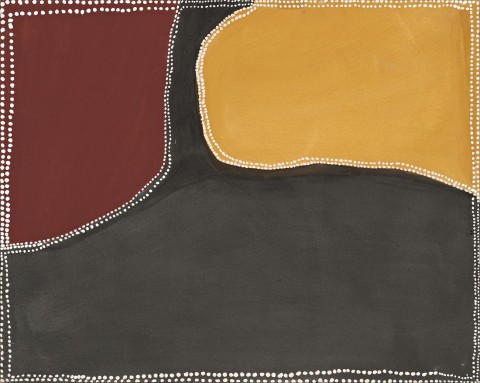RUBY PLAINS STATION, c.1992 – 93
ROVER THOMAS (JOOLAMA)
natural earth pigments and synthetic binders on canvas
80.5 x 100.5 cm
bears inscription verso: artist's name, size, and Waringarri Arts cat. AP3730 and S.3973
Waringarri Arts, Kununurra
Utopia Art Sydney, Sydney
Private collection
Mossgreen, Melbourne, 28 October 2014, lot 90
Company collection, Sydney
Idiosyncratic in style, the paintings of Rover Thomas established a new typology and visual language distinct to the east Kimberley region of Western Australia. Uniting both planar and aerial views of land in his compositions, Thomas articulated a highly personal way of telling the stories and establishing connection to the land and its related ceremonies.
The past and the present converge in Thomas's enigmatic paintings. They map tracts of country whilst exploring the regional history and the ancestral tales of these same locations. Thomas’s compositions carefully balance the landscape and the narrative in natural harmony, his canvases executed in earth pigments and natural resins are characterised by the interaction between large expanses and bold forms.
Painted for Waringarri Arts in Kununurra in the mid-1990s, Ruby Plains Station, c.1992 – 93, is typical of Rover’s paintings where layers of natural pigments affixed with a synthetic binder are outlined by a tracery of white dots painted with huntite, a white chalky pigment used in ceremony and rock art. The work shows a planar view of landscape where a large black expanse narrows between two imposing irregular forms infilled with yellow and red pigments that recall the rocky outcrops of the Kimberley plateau, while at the same time evoking ancestral paths and delineating areas of country.
During his lifetime, Rover Thomas was widely acclaimed as a major Australian artist. In 1990 he was selected as one of the first two Aboriginal artists (together with Trevor Nickolls), to represent Australia at the Venice Biennale and in 1994 was the beneficiary of a retrospective exhibition, Roads Cross, The Paintings of Rover Thomas, held at National Gallery of Australia, Canberra between February and June 1994. In his tribute to Rover Thomas after the artist’s death, Kim Akerman noted that, ‘as an artist he took the experiences of a rich and varied life and, drawing on the cosmological and historical references that so vividly underpin the lives of Aboriginal peoples throughout Australia, presented us all with a new and profound view of the land we occupy’.1
1. Akerman, K., ‘Rover Thomas; A Tribute’, ARTLINK, issue 20:1, March 2000, p. 22 – 23
CRISPIN GUTTERIDGE
